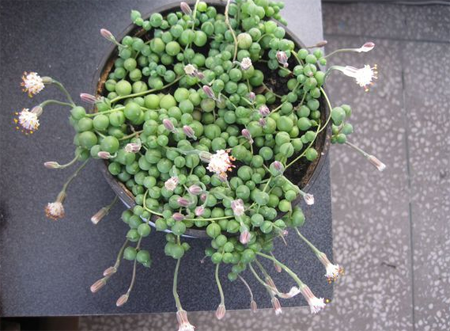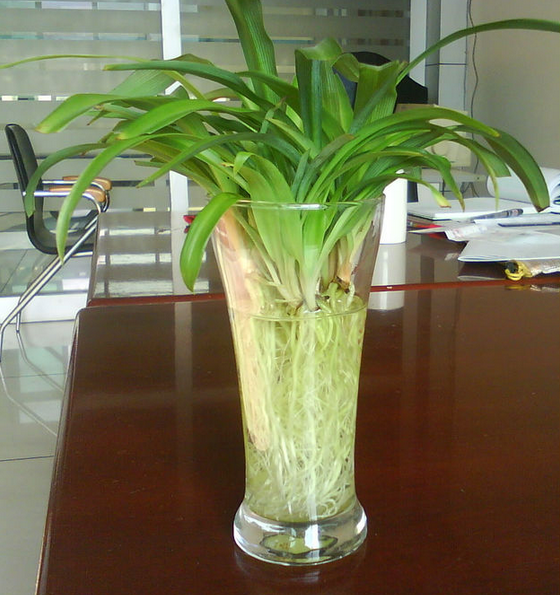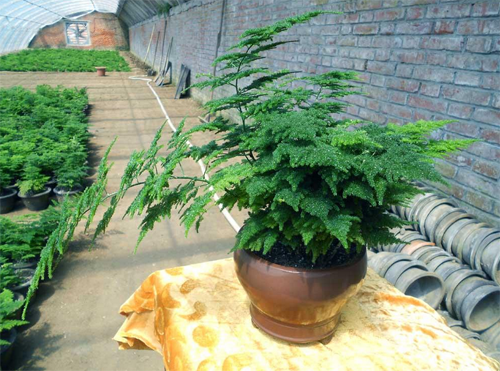The culture method and matters needing attention of Buddha bead orchid
Buddha bead orchid is very good-looking, many people like to raise, Buddha bead orchid is like a number of beads worn together, is very good-looking, but if you can not raise a good Buddha bead orchid will appear rotten meat rotten root situation, how to raise the Buddha bead hanging orchid? How long will it take to burst the basin? let's take a look at the Women's Network:

The culture methods of Buddha beads and orchids:
Buddha bead orchid and general plants have a lot of similarities, when breeding, we must pay attention to the coordination of temperature and water. It is not easy to breed such a life in a small flowerpot. Find a shallower flowerpot with shorter roots and easier to breathe in a shallow flowerpot. Pay attention to the coordination of temperature and water, this plant should not be watered in summer, so his roots are easy to rot, it is best to spray water with the spray bottles that ladies usually use, and the slow growth of the four seasons must be patiently cared for. Appropriate application of some fertilizer, do not need too much, he will slowly absorb.
Matters needing attention for Buddha beads hanging orchids:
Buddha bead orchid likes a relatively cool environment, so after taking care of it, it must be placed in a cool place and exposed to the sun. Like other plants, its leaves will slowly droop and lose its original color, or more seriously, it will wither and die. Similarly, he also needs plenty of oxygen and carbon dioxide, so it will be easier to survive in a ventilated place. It is best to turn the basin after long-term farming. Many small roots may have grown at the bottom of his basin that need to be taken care of, or need to be checked frequently to see if they have been watered too much, causing the roots to rot.
How long does the Buddha bead hanging orchid explode?
You can bury the small roots that come out of the branches into the soil, and cut them off after a period of time, so that one becomes two. The vitality of Buddha beads is very strong, and the basin will explode after a few months.
All laid flat on the soil, don't let him fall down and burst in the summer. I did this last year, but after the basin burst in summer, the water gradually melted away.
The knowledge of Buddha beads hanging orchid is introduced here, the breeding method is still very easy, but after the Buddha beads burst, it means death.
Can Buddha pearl orchids be hydroponically cultured? culture methods and matters needing attention of pearl orchids
There are many kinds of hanging orchids, such as Buddha beads, green orchids, pearl orchids, pearl orchids and pearl orchids look very much alike, but Buddha pearl orchids and pearl orchids cannot be raised by water, and only hydroponic hanging orchids can be raised by water. What matters needing attention are there in the process of raising pearl hanging orchids in soil? Let's take a look at the Women's Network:
Can Buddha bead orchids be raised in water?
It cannot be raised by water. Buddha beads and orchids are all succulent and have no leaves. As soon as they are soaked in the water, they will only rot.
Can pearl orchids be raised in water?
Hydroponic orchids are generally hydroponic, and pearl orchids are mainly cultivated in soil. because they like warm, humid and semi-shady environment, one of the unique characteristics of pearl orchids is drought resistance and cold resistance. And like loose and fertile soil rich in organic matter.
Culture methods and matters needing attention of pearl orchids:
1. The leaves are succulent and succulent, so they are resistant to drought. Watering should be dry rather than wet in cultivation, which is one of the keys to success. When the weather is dry, you can spray water to the leaves and vines to make up for the lack of moisture and keep the beads green and full. Prefer semi-shade, sun exposure may burn beads, too weak light will not grow strong.
2. The root system of the plant is very shallow and can be planted in shallow pot. Generally, tiles are used to cover the bottom holes and covered with a layer of cinder or coarse sand to increase air permeability and filtration (especially when plastic pots are commonly used nowadays). It is best to use rotten leaf soil (the fallen leaves of trees in autumn and winter are mixed with a certain amount of broken soil to be exposed to the wild grass. Mix in a certain amount of sand (the ratio of soil to sand is about 1:3).
3. Sex is warm and humid, cold-tolerant (low temperature of 0 ℃ in Jianghuai region), high temperature, and the optimum temperature is about 20 ℃ ~ 28 ℃. Both high temperature and low temperature grow slowly, especially when the temperature is more than 30 ℃, it is almost dormant. Less watering and fertilization should be done, otherwise the roots are easy to rot, which is also one of the keys to successful cultivation.
4. In the spring and autumn when the growth is exuberant, "thin fertilizer" should be applied frequently. Spraying 1-3 ‰ nitrogen fertilizer and potassium dihydrogen phosphate on the leaf surface is beneficial to make the pearl more green and fat and improve the ornamental value.
5. There are few diseases and insect pests, and aphids are one of them in spring, which should be wiped off or sprayed with 1500 times omethoate in time, while mites in summer and autumn should be killed with 1000 times triclofenac. Pay attention to ventilation and increase leaf humidity, can reduce the infection of mites.
6. Pearl orchid can be propagated by cuttage. Branches and vines are easy to take root and can be cut off in spring and autumn, half of which are buried in sand or loose soil, keeping moist but without stagnant water, and will soon take root for planting (about half a month in spring and autumn, while it is not easy to take root in winter and summer. This measure can be used to make up for the fact that the pot plants are not uniform and plump but grow too long.)
We must remember that the pearl orchid cannot be raised by water, and the water culture can only raise the meat of the orchid into water. How does it sound a little disgusting? the pearl orchid and the pearl orchid look very much alike, and the pearl orchid cannot be raised by water either.
What are the breeding methods and matters needing attention of Buddha beads and orchids?
[FAQ] what are the culture methods and matters needing attention of Buddha bead orchid?
[expert answers]
The culture methods of Buddha beads and orchids:
1. Methods of reproduction
The propagation method of Cymbidium is mostly cutting method, which can trim the branches and leaves, each section is 8-10 cm, then insert it into the basin soil, half cover, the humidity is controlled between 50% and 60%, take root in 10 days to half a month, and then take good care of it in order to survive. At this time, it is most beneficial to plant growth to strictly control the amount of water and keep the pot soil in the state between dry and wet.
2. Cultivation and management
Dry rather than wet is one of the key points in the cultivation of Cymbidium. In addition, it is also extremely important to apply thin fertilizer frequently. The so-called dry rather than wet is because the orchid from southern Africa likes a warm environment and is more drought-resistant than waterlogged, so it would rather be placed in a dry environment than stunted by too much watering. On the other hand, the frequent application of thin fertilizer says that fertilizer should be applied frequently, but each time it is light fertilizer, and one time it can not be fertilized too much, which leads to problems in its growth.
3. Pest prevention
In fact, there are few insect pests in Buddha bead orchids, but this is still the case. Generally speaking, the most common disease of Buddha bead orchid is aphid disease, which occurs in spring. When encountering this kind of phenomenon, it should be killed with 500 times omethoate. And in summer there will be mites, which can be killed 1000 times with triclofenac. When pests, pay attention to increase the humidity of the page, can reduce pests, in addition, ventilation facilities should also be in place.
Points for attention in the culture of Buddha beads and orchids:
1. The leaves are succulent and succulent, so they are resistant to drought. Watering should be dry rather than wet in cultivation, which is one of the keys to success. When the weather is dry, you can spray water to the leaves and vines to make up for the lack of moisture and keep the beads green and full. Prefer semi-shade, sun exposure may burn beads, too weak light will not grow strong.
2. The root system of the plant is very shallow and can be planted in shallow pot. Generally use tiles to cover the bottom hole, and cover with a layer of cinder or coarse sand to increase air permeability and filtration, the soil is best to use rotten leaf soil, mixed with a certain amount of sand, the soil-to-sand ratio is about 1:3.
3. Sex is warm and humid, cold-resistant and high-temperature resistant, and the optimum temperature is about 20 ℃ ~ 28 ℃. Both high temperature and low temperature grow slowly, especially when the temperature is more than 30 ℃, it is almost dormant. Less watering and fertilization should be done, otherwise the roots are easy to rot, which is also one of the keys to successful cultivation.
4. In the spring and autumn when the growth is exuberant, "thin fertilizer" should be applied frequently. Spraying 1-3 ‰ nitrogen fertilizer and potassium dihydrogen phosphate on the leaf surface is beneficial to make the pearl more green and fat and improve the ornamental value.
[editor's comments] Fozhu Cymbidium is a kind of foliage succulent plant. The above is the breeding method and matters needing attention introduced by the first Agricultural Classic Xiaoban. I believe you will know more about it after reading this article. I hope this article will be helpful to you, thank you for your attention and support to our website!
- Prev

Culture methods and matters needing attention of hydroponic Cymbidium how to deal with blackened leaf tip and rotten root
Hydroponic Cymbidium is relatively simple, you only need to put it in water, but there are still a lot of matters needing attention in the process of aquaculture. What about the black and rotten root of leaf tip in the process of appearance?
- Next

How to make and prune bonsai when asparagus grows?
Asparagus is very good-looking and is very suitable for bonsai, but asparagus grows taller and taller in the basin and is not good-looking at all. How can asparagus not grow taller? Bonsai must be short to look good, asparagus must be often trimmed to look good, how to trim asparagus usually?
Related
- Fuxing push coffee new agricultural production and marketing class: lack of small-scale processing plants
- Jujube rice field leisure farm deep ploughing Yilan for five years to create a space for organic food and play
- Nongyu Farm-A trial of organic papaya for brave women with advanced technology
- Four points for attention in the prevention and control of diseases and insect pests of edible fungi
- How to add nutrient solution to Edible Fungi
- Is there any good way to control edible fungus mites?
- Open Inoculation Technology of Edible Fungi
- Is there any clever way to use fertilizer for edible fungus in winter?
- What agents are used to kill the pathogens of edible fungi in the mushroom shed?
- Rapid drying of Edible Fungi

